Viscoelastic Properties and Thermal Stability of Nanohydroxyapatite Reinforced Poly-Lactic Acid for Load Bearing Applications
Abstract
:1. Introduction
2. Materials
2.1. Preparation of Nanocomposites
2.2. Dynamic Mechanical Analysis (DMA)
2.3. Thermal Stability
2.4. Field Emission Scanning Electron Microscope (FESEM)
3. Results and Discussion
3.1. Mixing Torque
3.2. Surface Morphology
3.3. Storage Modulus
3.4. Damping Parameter
3.5. Creep and Recovery
3.6. Thermal Stability
3.6.1. Thermogravimetric Analysis
3.6.2. Differential Scanning Calorimetry
4. Conclusions
Author Contributions
Funding
Institutional Review Board Statement
Informed Consent Statement
Data Availability Statement
Acknowledgments
Conflicts of Interest
Sample Availability
References
- Michael, F.M.; Ratnam, C.T.; Khalid, M.; Ramarad, S.; Walvekar, R. Surface modification of nanohydroxyapatite and its loading effect on polylactic acid properties for load bearing implants. Polym. Compos. 2018, 39, 2880–2888. [Google Scholar] [CrossRef]
- Michael, F.M.; Khalid, M.; Walvekar, R.; Ratnam, C.T.; Ramarad, S.; Siddiqui, H.; Hoque, M.E. Effect of nanofillers on the physico-mechanical properties of load bearing bone implants. Mater. Sci. Eng. C 2016, 67, 792–806. [Google Scholar] [CrossRef] [PubMed]
- Kim, S.M.; Kang, I.G.; Cheon, K.H.; Jang, T.S.; Kim, H.E.; Jung, H.D.; Kang, M.H. Enhanced bioactivity of micropatterned hydroxyapatite embedded poly(L-lactic) acid for a load-bearing implant. Polymer 2020, 12, 2390. [Google Scholar] [CrossRef] [PubMed]
- Jiang, L.; Xiong, C.; Chen, D.; Jiang, D.; Pang, X. Effect of n-HA with different surface-modified on the properties of n-HA/PLGA composite. Appl. Surf. Sci. 2012, 259, 72–78. [Google Scholar]
- Ferri, J.M.; Jordá, J.; Montanes, N.; Fenollar, O.; Balart, R. Manufacturing and characterization of poly(lactic acid) composites with hydroxyapatite. J. Thermoplast. Compos. Mater. 2018, 31, 865–881. [Google Scholar] [CrossRef]
- Vieira, A.C.; Medeiros, R.; Guedes, R.M.; Marques, A.T.; Tita, V. Visco-elastic-plastic properties of suture fibers made of PLA-PCL. Mater. Sci. Forum 2013, 730, 56–61. [Google Scholar] [CrossRef]
- Akindoyo, J.O.; Beg, M.D.; Ghazali, S.; Heim, H.P.; Feldmann, M. Effects of surface modification on dispersion, mechanical, thermal and dynamic mechanical properties of injection molded PLA-hydroxyapatite composites. Compos. Part A Appl. Sci. Manuf. 2017, 103, 96–105. [Google Scholar] [CrossRef]
- Zhang, R.; Hu, H.; Liu, Y.; Tan, J.; Chen, W.; Ying, C.; Wong, C.P. Homogeneously dispersed composites of hydroxyapatite nanorods and poly(lactic acid) and their mechanical properties and crystallization behavior. Compos. Part A Appl. Sci. Manuf. 2020, 132, 105841. [Google Scholar] [CrossRef]
- Patti, A.; Acierno, D.; Latteri, A.; Tosto, C.; Pergolizzi, E.; Recca, G.; Cristaudo, M.; Cicala, G. Influence of the processing conditions on the mechanical performance of sustainable bio-based PLA compounds. Polymer 2020, 12, 2197. [Google Scholar] [CrossRef] [PubMed]
- Oluwabunmi, K.; D’Souza, N.A.; Zhao, W.; Choi, T.Y.; Theyson, T. Compostable, fully biobased foams using PLA and micro cellulose for zero energy buildings. Sci. Rep. 2020, 10, 1–20. [Google Scholar] [CrossRef] [PubMed]
- Jeziorska, R.; Szadkowska, A.; Spasowka, E.; Lukomska, A.; Chmielarek, M. Characteristics of Biodegradable Polylactide/Thermoplastic Starch/Nanosilica Composites: Effects of Plasticizer and Nanosilica Functionality. Adv. Mater. Sci. Eng. 2018, 2018, A4571368. [Google Scholar] [CrossRef] [Green Version]
- Shojaeiarani, J.; Bajwa, D.S.; Stark, N.M.; Bajwa, S.G. Rheological properties of cellulose nanocrystals engineered polylactic acid nanocomposites. Compos. Part B Eng. 2019, 161, 483–489. [Google Scholar] [CrossRef]
- Eng, C.C.; Ibrahim, N.A.; Zainuddin, N.; Ariffin, H.; Yunus, W.M.; Wan, Z.; Then, Y.Y. Enhancement of mechanical and dynamic mechanical properties of hydrophilic nanoclay reinforced polylactic acid/polycaprolactone/oil palm mesocarp fiber hybrid composites. Int. J. Polym. Sci. 2014, 2014, A715801. [Google Scholar] [CrossRef]
- Shi, X.; Zhang, G.; Phuong, T.V.; Lazzeri, A. Synergistic effects of nucleating agents and plasticizers on the crystallization behavior of Poly(lactic acid). Molecules 2015, 20, 1579–1593. [Google Scholar] [CrossRef] [PubMed]
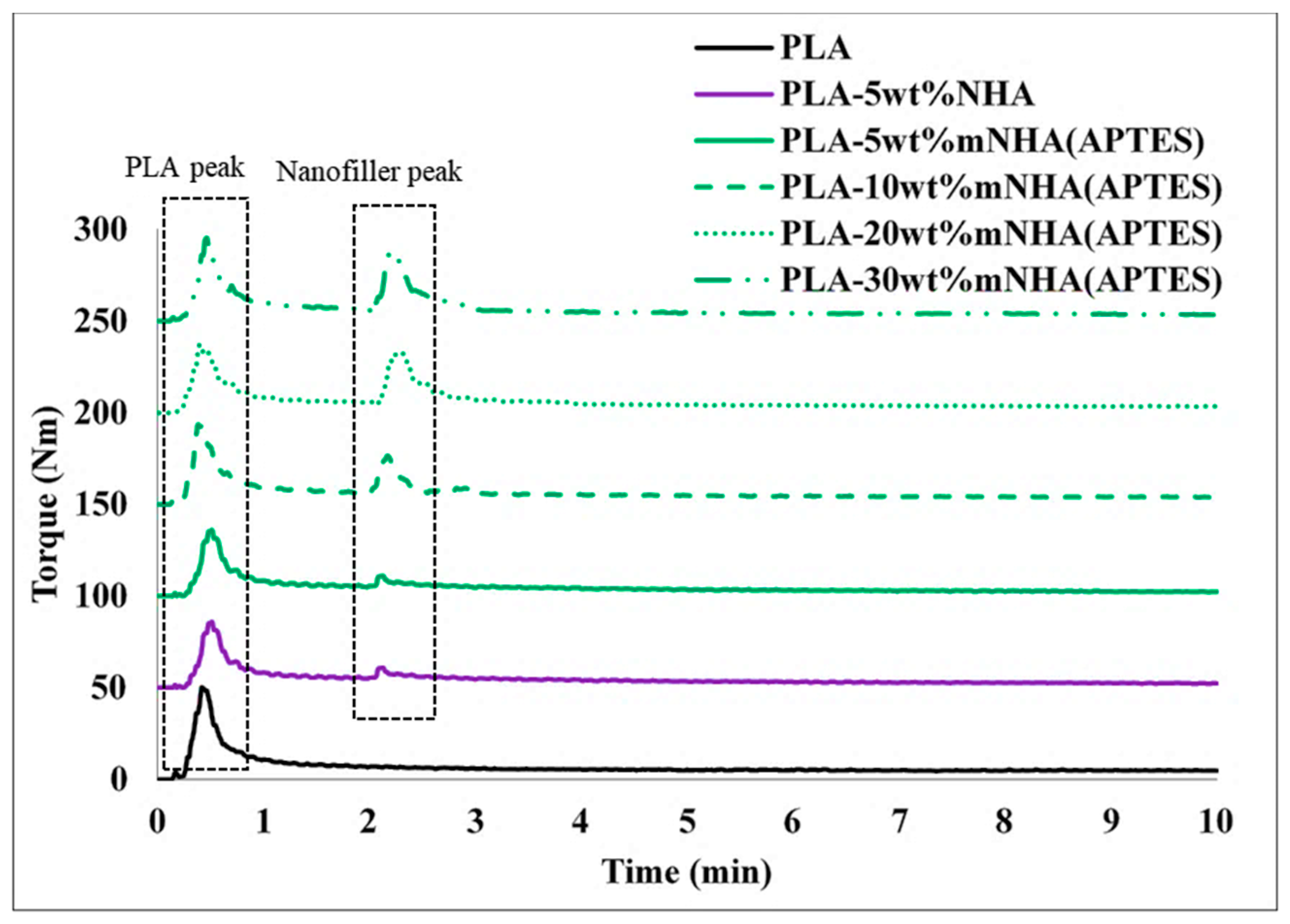
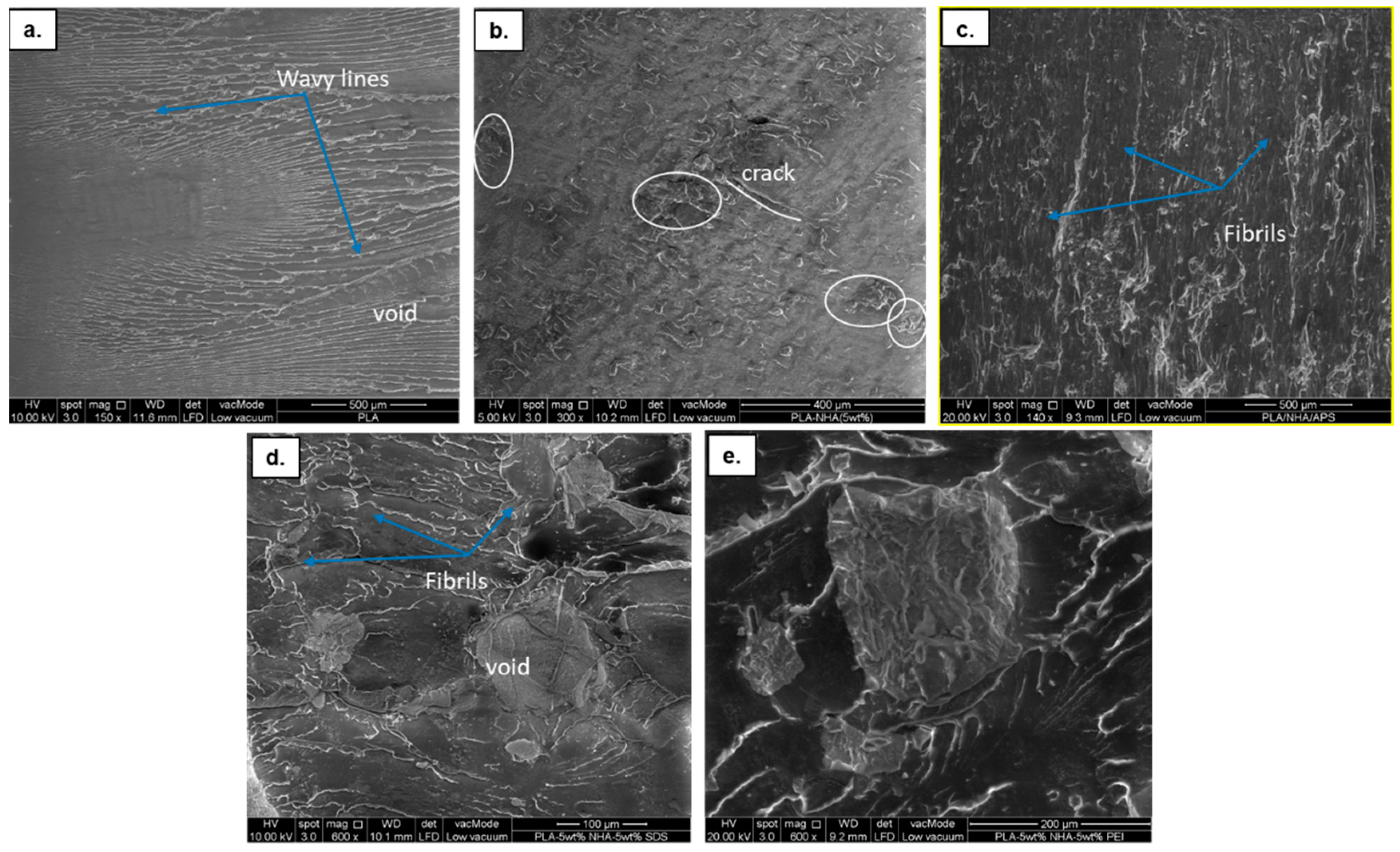
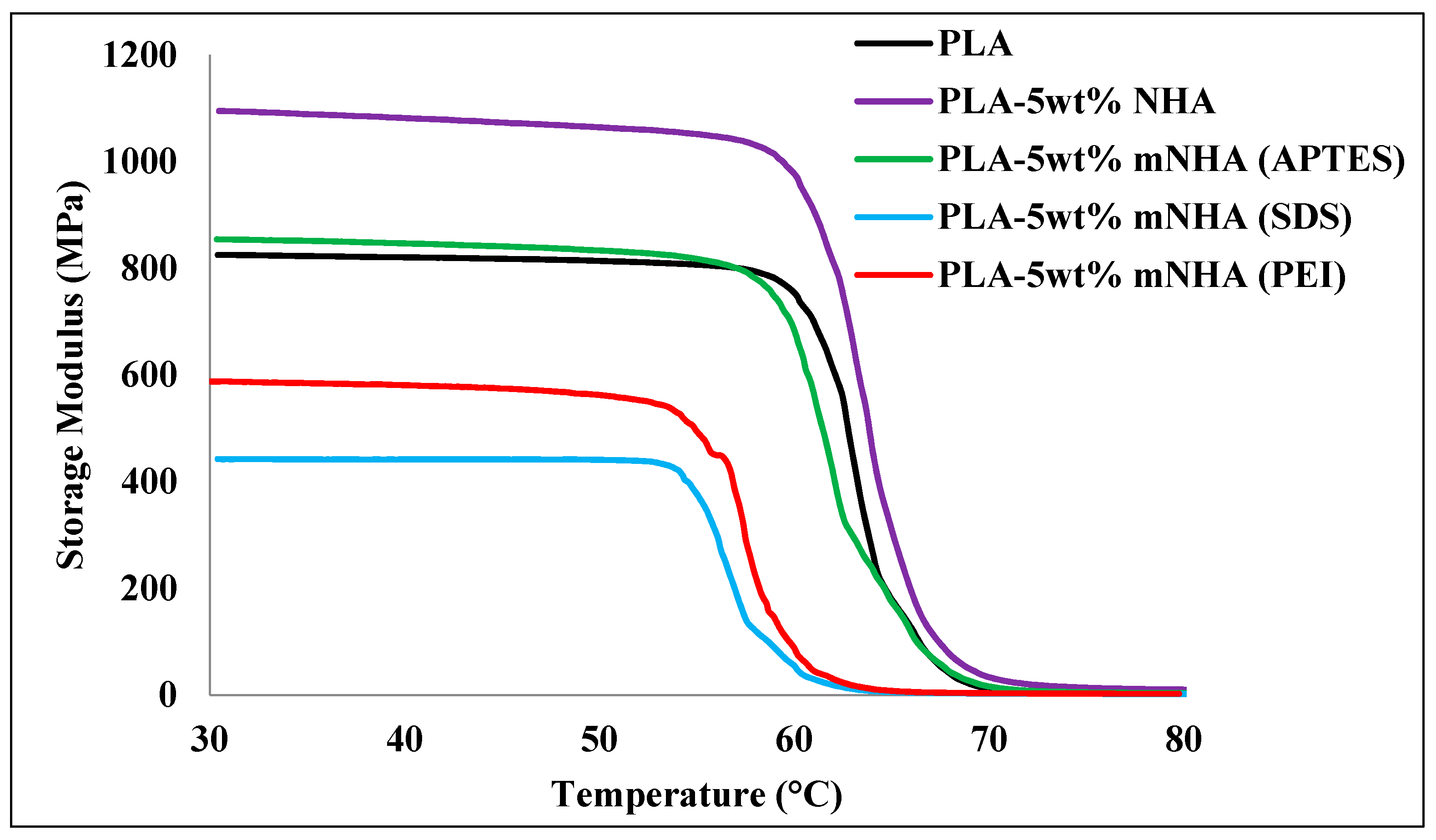
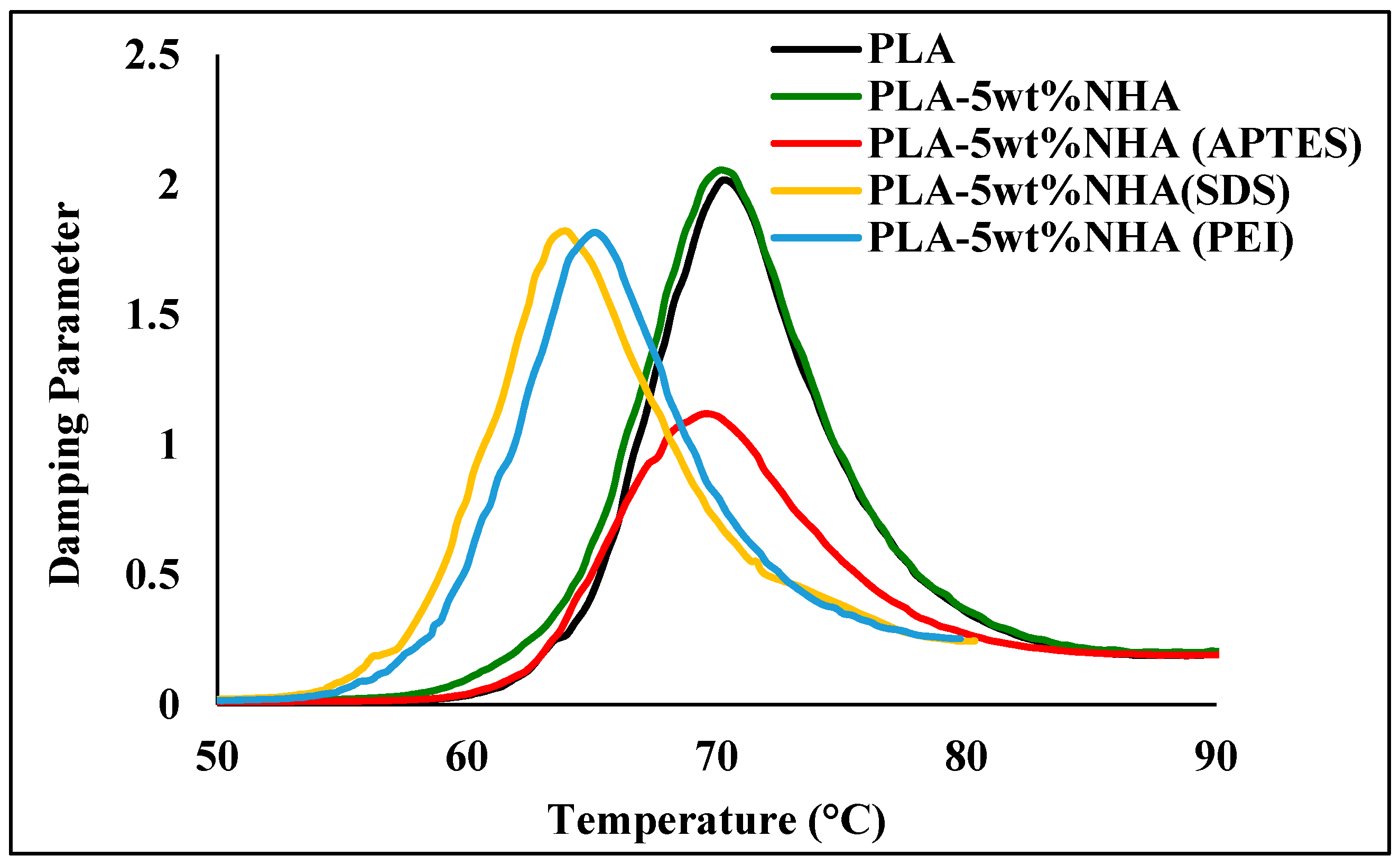
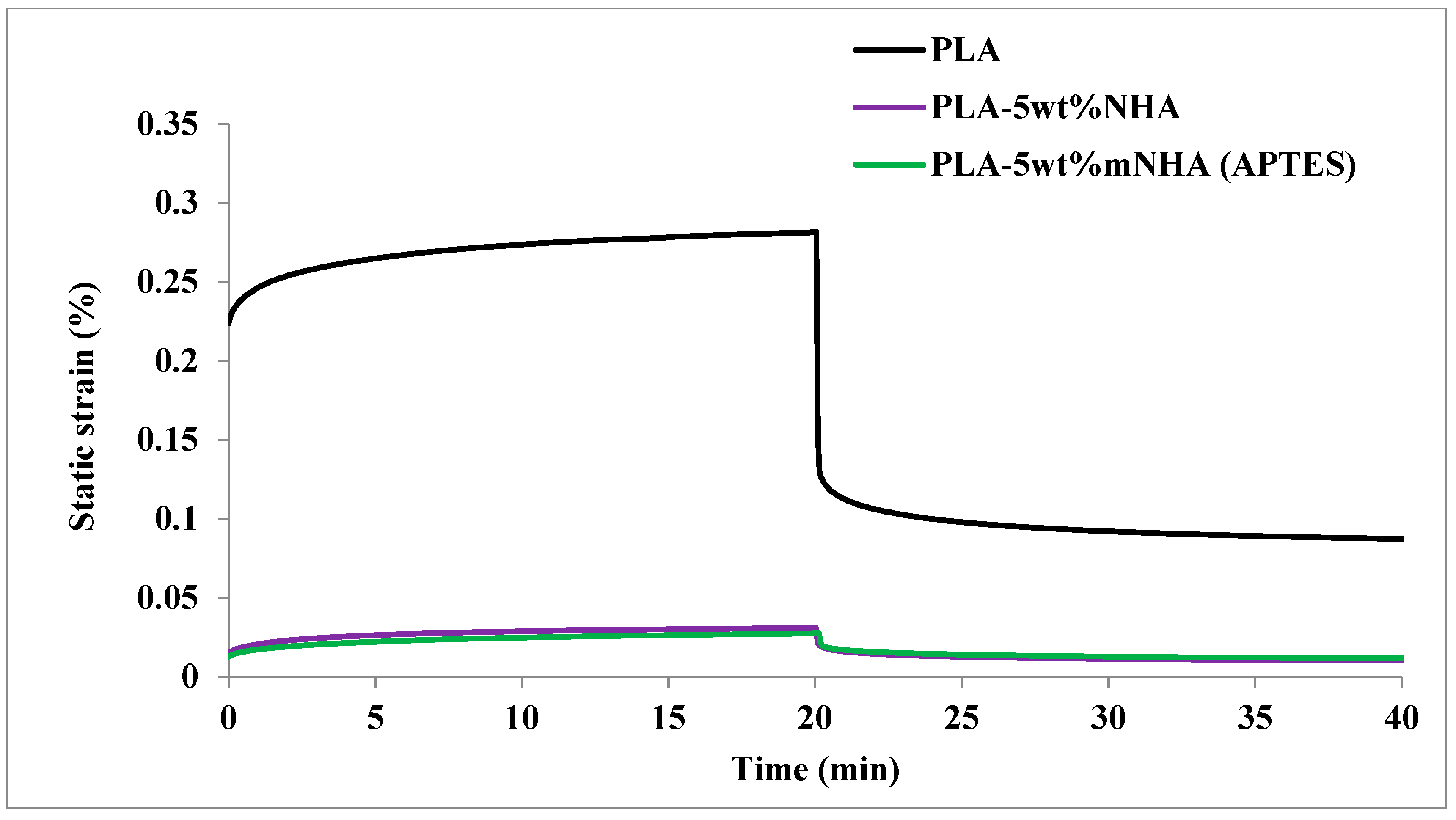
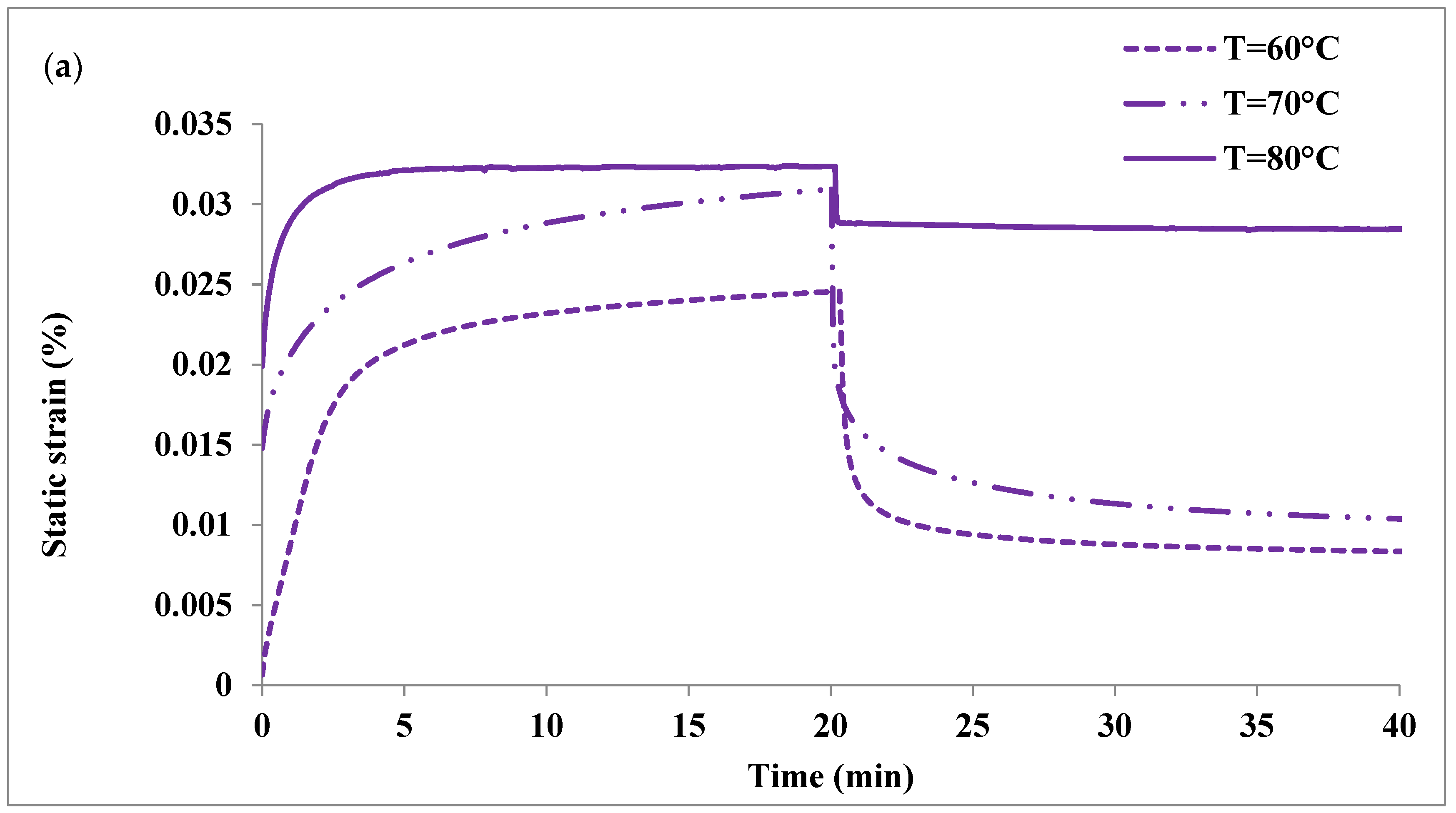
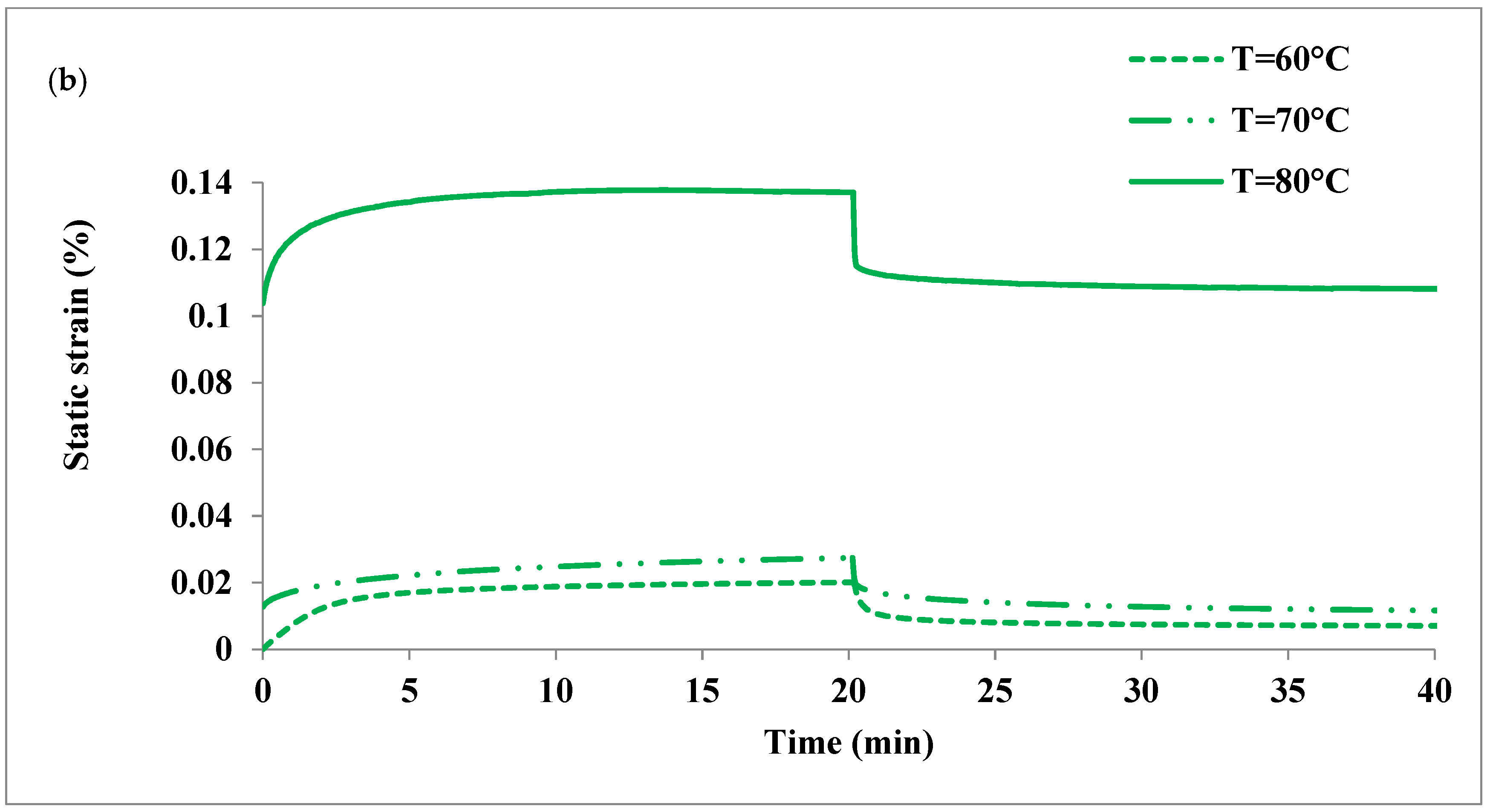

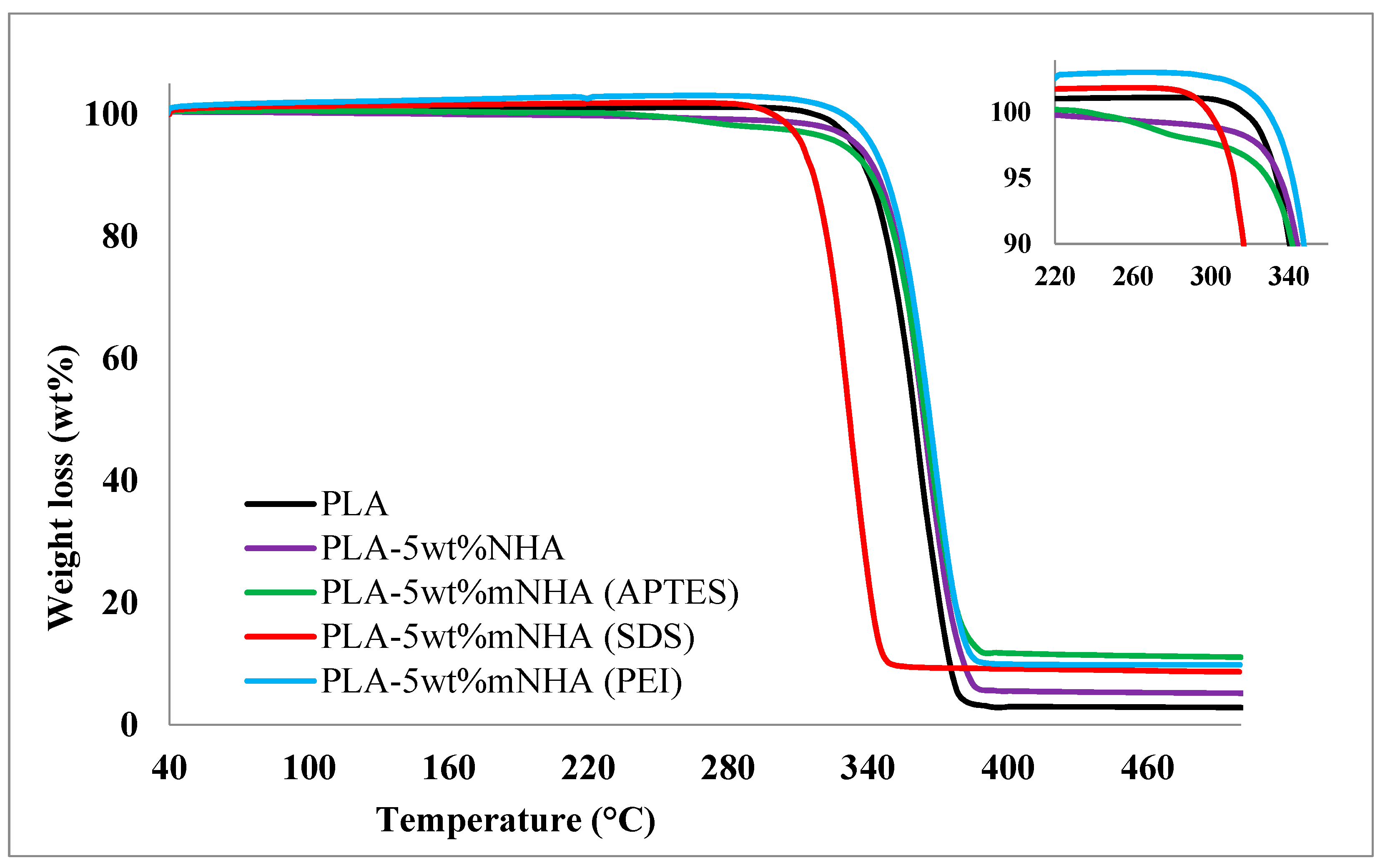
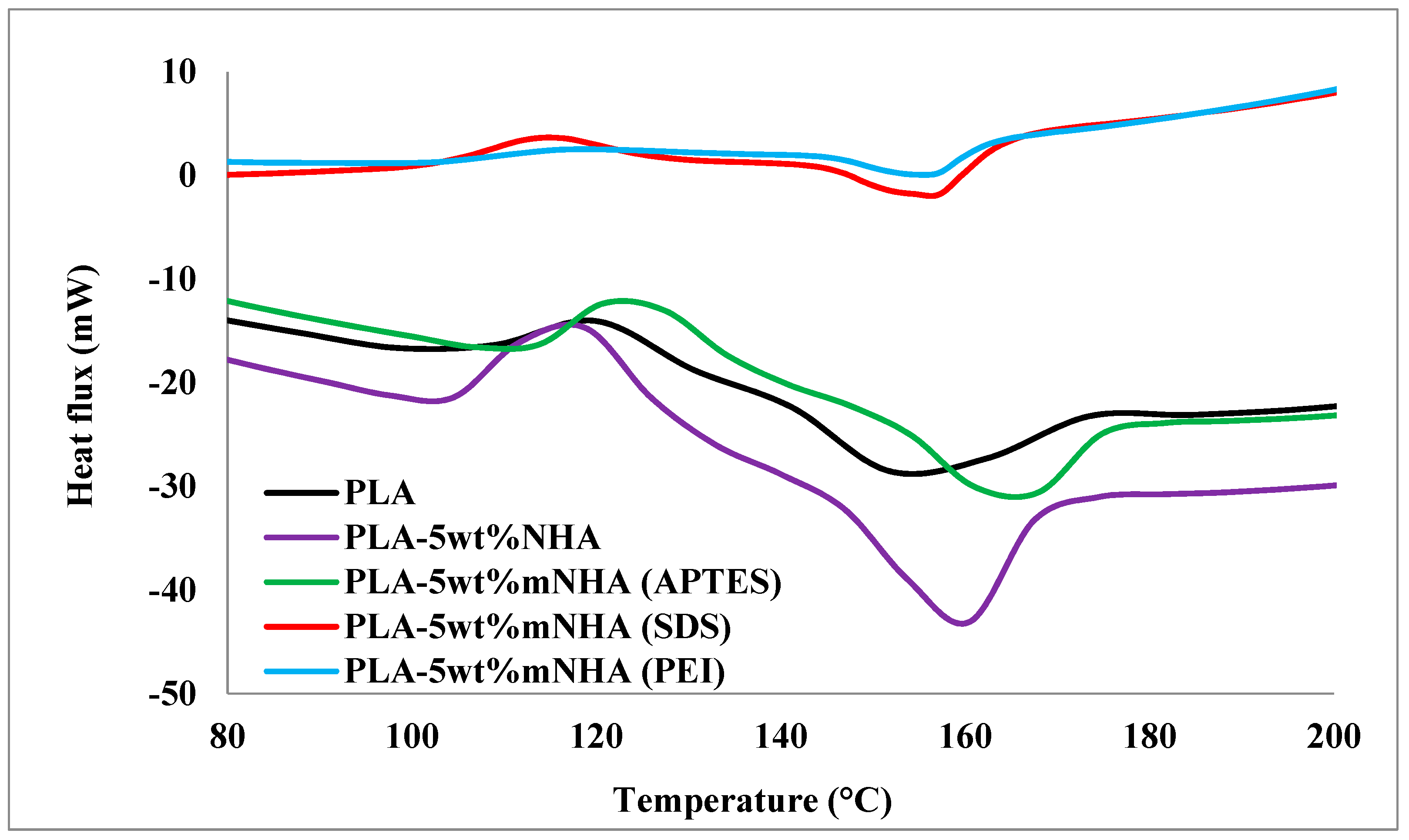
| Designation | PLA (wt%) | NHA (wt%) | mNHA (wt%) |
|---|---|---|---|
| PLA | 100 | - | - |
| PLA-5wt%NHA | 95 | 5 | - |
| PLA-5wt%mNHA (APTES) | 95 | - | 5 |
| PLA-5wt%mNHA (SDS) | 95 | - | 5 |
| PLA-5wt%mNHA (PEI) | 95 | - | 5 |
| Sample | Storage Modulus (MPa) | Tg (°C) | Damping Parameter | C | Storage Modulus Retention (%) | |||
|---|---|---|---|---|---|---|---|---|
| E′50 °C/E′40 °C | E’60 °C/E′40 °C | E′70 °C/E′40 °C | E′80 °C/E′40 °C | |||||
| PLA | 821.58 | 70.24 | 2.04 | - | 99 | 91 | 1.3 | 0.3 |
| PLA-5wt%NHA | 1086.13 | 69.64 | 2.04 | 0.37 | 98 | 90 | 3 | 0.9 |
| PLA-5wt%mNHA (APTES) | 849.61 | 70.06 | 1.12 | 0.81 | 98 | 80 | 1.8 | 0.4 |
| PLA-5wt%mNHA (SDS) | 442.32 | 63.69 | 1.81 | 0.85 | 99 | 12.4 | 0.6 | 0.4 |
| PLA-5wt%mNHA (PEI) | 590.88 | 65.11 | 1.82 | 0.87 | 97 | 12.6 | 0.5 | 0.4 |
| Sample | Condition | Creep Strain | Recovery Strain | Residual Strain |
|---|---|---|---|---|
| PLA | T = 70 °C | 0.2814 | 0.1940 | 0.0874 |
| PLA-5wt%NHA | T = 60 °C | 0.0246 | 0.0162 | 0.0084 |
| T = 70 °C | 0.0309 | 0.0205 | 0.0104 | |
| T = 80 °C | 0.0324 | 0.0039 | 0.0285 | |
| PLA-5wt%mNHA (APTES) | T = 60 °C | 0.0215 | 0.0144 | 0.0071 |
| T = 70 °C | 0.0274 | 0.0157 | 0.0117 | |
| T = 80 °C | 0.1371 | 0.0290 | 0.1081 | |
| PLA-5wt%mNHA (SDS) | T = 70 °C | 0.0275 | 0.0157 | 0.0118 |
| PLA-5wt%mNHA (PEI) | T = 70 °C | 0.0301 | 0.0193 | 0.0108 |
| Samples | TGA Results | DSC Results | |||||||
|---|---|---|---|---|---|---|---|---|---|
| T5% (°C) | T10% (°C) | T50% (°C) | Max Tdeg (°C) | Remaining Weight (%) | Tc (°C) | Heat Flow (mW) | Tm (°C) | Heat Flow (mW) | |
| PLA | 332.8 | 339.4 | 360.1 | 367.5 | 2.91 | 125.2 | −17.19 | 151.8 | −28.53 |
| PLA-5wt%NHA | 332.8 | 339.4 | 360.1 | 368.9 | 5.29 | 118.8 | −14.69 | 160.5 | −43.08 |
| PLA-5wt% mNHA (APTES) | 326.9 | 340.5 | 364.9 | 371.5 | 11.09 | 127.4 | −13.04 | 167.9 | −30.60 |
| PLA-5wt% mNHA (SDS) | 311.5 | 316.4 | 331.7 | 335.4 | 8.68 | 114.2 | 3.66 | 155.6 | −16.22 |
| PLA-5wt% mNHA (PEI) | 341.6 | 342.6 | 366.4 | 370.4 | 9.83 | - | - | 154.7 | 0.08 |
Publisher’s Note: MDPI stays neutral with regard to jurisdictional claims in published maps and institutional affiliations. |
© 2021 by the authors. Licensee MDPI, Basel, Switzerland. This article is an open access article distributed under the terms and conditions of the Creative Commons Attribution (CC BY) license (https://creativecommons.org/licenses/by/4.0/).
Share and Cite
Michael, F.M.; Khalid, M.; Raju, G.; Ratnam, C.T.; Walvekar, R.; Mubarak, N.M. Viscoelastic Properties and Thermal Stability of Nanohydroxyapatite Reinforced Poly-Lactic Acid for Load Bearing Applications. Molecules 2021, 26, 5852. https://doi.org/10.3390/molecules26195852
Michael FM, Khalid M, Raju G, Ratnam CT, Walvekar R, Mubarak NM. Viscoelastic Properties and Thermal Stability of Nanohydroxyapatite Reinforced Poly-Lactic Acid for Load Bearing Applications. Molecules. 2021; 26(19):5852. https://doi.org/10.3390/molecules26195852
Chicago/Turabian StyleMichael, Feven Mattews, Mohammad Khalid, Gunasunderi Raju, Chantara Thevy Ratnam, Rashmi Walvekar, and Nabisab Mujawar Mubarak. 2021. "Viscoelastic Properties and Thermal Stability of Nanohydroxyapatite Reinforced Poly-Lactic Acid for Load Bearing Applications" Molecules 26, no. 19: 5852. https://doi.org/10.3390/molecules26195852






